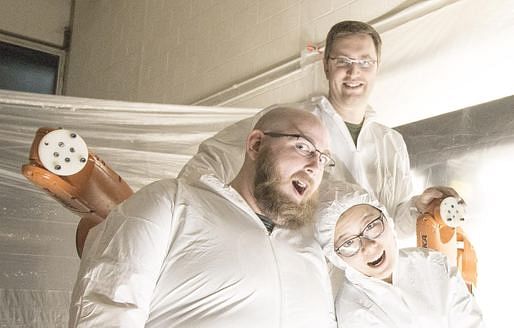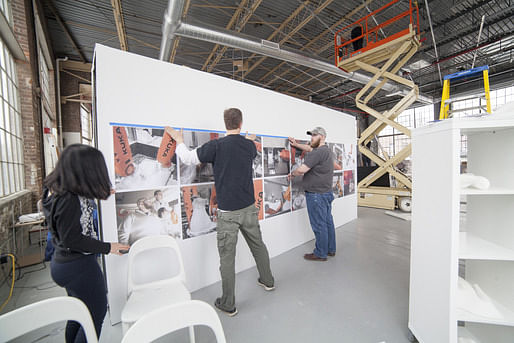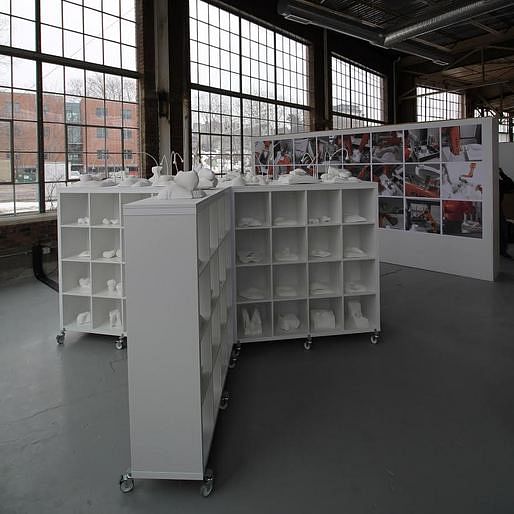
Research through Making started in 2009 at Taubman College and enables faculty to engage in innovative architectural projects that are predicated on making. Five projects are awarded each year through a blind jury process where faculty collaborate with students and experts in other fields of research to experiment and produce projects that address various issues and opportunities in architecture. _____________________________________________________________________

This year, a variety of unique projects was presented and is currently on public exhibition at the Liberty Annex Gallery in Ann Arbor that ranges from new material technologies as tactile interfaces to exploring ways in which climate, materials, and electricity can interact to create architectural surfaces and nuanced effects.
Among the five awarded projects is RoboPinch, using robots as a speculative collaborator in the production of plaster form and volume studies. The project was led by Karl Daubmann, director of the Masters of Science in Architecture Degree and Associate Professor in Architecture at Taubman College. RoboPInch makes voluptuous and volumetrically complex, manifold models using very precise tools through a delicate balance of discovery and empirical / iterative making. Where the human hand excels in the tangible and sensual relationship to material, the robotic hand brings precision, reproducibility, and the ability to re-calibrate and tune parametric design decisions.
Right before the opening of the exhibition, Karl made some time in his schedule to sit down and talk about his research.
My understanding is that you knew early on precisely what it is you wanted to research and your proposal for the 2015 Research Through Making project was quite concise. Can you tell us a little bit about where the research proposal came from?
The project originated in my undergraduate design studio last year and also came from a variety of different sources. The UG2 studio looked at buildings and site, so that was one trajectory that we wanted to test. The other thing that I was interested in was using the robots. There has been a growing concern on my part about digital fabrication and how literal it is. My gut feeling is that as architects we speculate at our desk with our drawings and with our models and with things close by. What I started seeing more and more happening with discussions around work that grows out of digital fabrication is that students say, “this is it!” But my response to that is, “well could it be this?...What about this?...what were you really speculating on and can the process change?” But the student would reply with, “well I made THIS!” But that’s a one-to-one thing, and I actually think that type of speculation is better served as a contractor. Polemically I continue to hold onto the belief that architects don’t build things, architects design things. In order to help us speculate on how and what we design, the model is an important part of the process.
I was interested in the robots but not to produce full scale things, but to produce representation of buildings and think about these representations as physical models. What’s interesting about the robots is that they are flexible and we can put a lot of tools on them. They also reproduce actions really well, so if we go to a certain location and space, we can do the same thing again. We coupled the use of the robots with fabric formwork and with plaster. So there are three things happening together: the robots, the fabric formwork that allows us to make formwork that stretches, distorts, and changes, and plaster as a really inexpensive material. So then the other part is prototyping. With 3D printing, you start with a digital model and then you print it and you get exactly a physical one-to-one of that thing. It’s rarely surprising when you get that thing, it’s not exciting because it’s exactly the thing that you printed. RoboPinch wanted to be surprised by the process of making. Such as how fluid the plaster is, how flexible the fabric is, what we do with the robot in order to make a form produces things that we were constantly excited by when we pulled them out of the formwork. But if we really liked it, we can have the robot repeat the position and produce another one.
There’s also a parametric way of thinking about it. For example if we have a cube, and it’s flexible on one side or two sides and we can push with the robots more or less with them and so if we wanted to tweak something or fine tune something, we can do another version and have the robot make a slightly different gesture and movement. The other thing that was really exciting is that any of the CNC routers or mills work subtractively, so you start with a block of something and through a lot of dust and subtraction, you end up with something else. For us, if we have the robot apply a force, that was a subtraction of virtual material. If we poke the cube from one side, then we cast it with plaster we end up with a void. We don’t make a cube and then subtract, subtract, subtract. With our process, there was a way that we can distort the formwork that begins to approximate the form that we want. In industrial applications, sand casting is used to approximate a part and where it needs to be precise, it gets milled in finished. So there’s a way that you can approximate the material and the formwork you want beforehand with casting and then rework the part more precisely afterwards. With the plaster; we can sand it, we can scrape it, and we can drill it so there were opportunities to post-process the material. RoboPinch is an interesting way to use inexpensive material that is easy and quick to work with as a way to make design models. Then it was about thinking of the relationship between buildings and site. The exhibit is set up in a way that the lower display area shows the studies of formwork; and the top shelf is populated of architectural models with people where we start to think about scale and site.


It seems that your research mainly delves into the relationship between the material and how the robot would perform with the material. How much of this interaction affected the process?
Quite a bit actually. I worked with two undergraduates; Stella Zhang from my undergraduate studio and Ric Foley from my robotics seminar last winter. Additional help was also provided by Patrick Ethen, Claire Matucheski, and Luis Orozco. There was a lot of experimentation; rarely did we say we want to make this specific thing. We approached it with an idea for a type of formwork by poking it, pushing it, or pulling it with the robot, and then we would try it. Because the plaster is so cheap, it was easy to try things - if we liked it, we would move from there. If we didn’t like it, we would try it a couple more times. Stella and Ric got really accustomed to asking, “should we do this, should we do that?” and I would say, “yes, we should do both!” So very often when we set up the robots, we would work for an entire day experimenting. It takes no more than ten minutes for the plaster to cure and while the robots hold it in place; we could be setting up another test. We used the small robots as an intelligent jig, so that we can move them, position them, and then hold the formwork in place.


How many variations did you go through?
Many many many ….The shelves that we built for the exhibit have 96 cells and then there are the finished models on top of the shelves. I’d say that what’s here in the exhibition is about 70% of what we made.
What was your expectation going into the project and how did that differ, if at all, from the outcome?
That’s a really good question. I kept talking to Stella and Ric about this. If this was a project in an office, I think it would be much more directed. But Research through Making gives you an opportunity to experiment, and at least for me, to not go in with too many expectations. I approach the project more like, “here’s a general idea, let’s see where it takes us and where it goes.” From that perspective, driving the thing, there weren’t a lot of expectations. I particularly like the small robots because most people see them as the training wheels for the big robots. But I see the scale of the robots and how we work with them as something more closely to what we do as architects and making models. And so I’d like to see people start thinking more about the relationship or the connection between working digitally and using the robots to think about making models. I’ll be delivering a paper at a conference in Amsterdam this summer to the International Society of Flexible Formwork. There’s a community of people who are interested in other methods of casting things and I am excited to enter into this broader industry discussion. The thing that we didn’t do is that we never made any drawings, and we never made any computer models. So we never started with a form first. The only thing that we modeled was jigs and robotic actions and gesture.

Even within your research process, you never worked between model making, drawings, and 3D modeling? You didn't really code the robots to pinch or pull in a specific way to generate a form right?
Not so much. The only coding was the robot on an experimental base such as prompting questions such as, “what if the robots did this, what if the robots did that, how does that change the formwork…” There were discussions about taking the product and producing drawings of the form, but it was less a notion of having a form and now we want to make it, it was much more of what the process gives us. The fluid nature of plaster gives a particular material feedback, and the different types of stretchy fabric affected the way the plaster formed with the use and control of the robot. Those three things gave us a lot of possibilities and I don’t feel like we’ve got through all the examples that we want to try. We did some CNC fabric cutting and if we could sew better, we’d be looking at a different range of fabric formwork.
It seems that the fluid nature of plaster helped enriched the variations within your research, but if you were to continue working on the project would you consider using a different material?
Maybe it would depend on the specific application. Plaster is really cheap, so we were able to make more things with it and it was an issue to see if it would be a viable approach for a design studio for students. A more expensive material would preclude that messy way of working for students. But with plaster we could sand it, scrape it, cut it, and continue to work on it. If we were to use concrete or rockite, we wouldn’t be able to do that. The fact that it was quick to cure was another really nice aspect to it. If it were to scale up, obviously the material would have to change, but I think there’s a long history of plaster models, which I’m excited to continue to research.

How do you see your research and the use of the robot arms being applied to the discipline of architecture, not only for someone interested in fabrication and using the robots in model making, but also the process in casting with fabric and plaster for model making?
The precedent that I hold quite highly is the Gaudi hanging chain model. In that case Gaudi inverted the building and hangs chains with weights on it that holds a certain form. So there’s a really nice relationship between the tactility of that, seeing that, and then knowing that he can translate that, scale that and turn it into building or structure. Being able to work with the material directly but also use the robots to connect that process is really important. Also with the fabric formwork, we had to think about gravity and the inversion of the material. So we can cast something in a particular shape, but due to the force of gravity, the material will start to shape differently. But using the robots, we can turn and pull the formwork in different directions while gravity is still pulling downwards. So by manipulating the different axis with the robots, we end up with a variety of forms not completely dictated by gravity or by using gravity in a specific way or orientation. In my studio last year, Stella made her buildings first, and then put them upside down and then cast the site against her buildings. There’s a really strong relationship between that kind of thinking and the inversion of model making from Gaudi.
The big issue for me has always been that architects work in a strange way. We come up with a form first and then we figure out what that material may be in the end. I think materials have lots of properties and different ways to work with them and they’re full of suggestions. Because the plaster is fluid and because the fabric distorts a certain way, RoboPinch didn’t want to have a form first, we found possibilities through the materials. That’s a kind of key way that I work on my projects. I try to listen to the process and see what comes out of the process instead of this heroic notion of thinking no matter what the material does, I’m going to beat it into submission.
Do you see the use of robots and your research being applied in construction and larger scale projects?
The way that we’re working and how we’re thinking about the building as one-to-one, scale it means we would need big huge giant robots that would make the buildings in one piece. That’s not what we’re suggesting necessarily, I think there would have to be another process of thinking about the tectonic way of working with the parts and robots.I do believe strongly between the relationship of the materials and construction, whether it’s large scale or small scale. For example the laser cutter and the water-jet cutter, you use the same file for both of them but with the laser cutter you can cut things to make a model, but with the water-jet you can cut big sheets of steel for different scales or types of models. I am very interested in this ability to use a small tool at your desk and test certain things, possibly thinking about the surface of your desk as the site and how you would build something and then applying that same set of codes to the robots. So I think there are opportunities to extend that kind of thinking in construction, but I think there is a lot of work that needs to be done. Most industrial robots are used in manufacturing, architecture is not manufacturing, which is why we say construction and not manufacturing. The four years that I worked with Blu Homes gave me a great opportunity to engage manufacturing of architecture and a key takeaway is to think of things as products and not as one-offs. As long as things stay completely unique, we’re not going to see robots do critical aspects of construction. While there are repetitive tasks, construction tends to be adaptable as tradespeople make a lot of decisions along the way. I think the work that we’re doing right now with the robot works more as a prototype because we can produce certain movements, it’s stable, and it’s predictable. Where we really see robots is in manufacturing having a greater impact is where you can do things over and over again.
Are you excited to be done with the project?
Yes and no. The team that I worked with was wonderful so I wish that I could keep working with Stella and Ric for another year. We were incredibly experimental and it was so much fun. I’m glad to be done setting up the exhibit, but I’m sad I won’t have any more Saturday morning robot sessions with the team as it was quite an enjoyable routine. . Maybe we will reunite the team for a different project!
For more information about the project visit daub-lab.com or #robopinch on Instagram.


Sharing insights from Taubman College of Architecture and Urban Planning at the University of Michigan.



No Comments
Block this user
Are you sure you want to block this user and hide all related comments throughout the site?
Archinect
This is your first comment on Archinect. Your comment will be visible once approved.